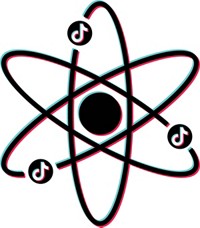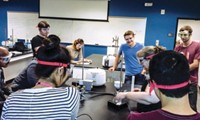Advertisement
Grab your lab coat. Let's get started
Welcome!
Welcome!
Create an account below to get 6 C&EN articles per month, receive newsletters and more - all free.
It seems this is your first time logging in online. Please enter the following information to continue.
As an ACS member you automatically get access to this site. All we need is few more details to create your reading experience.
Not you? Sign in with a different account.
Not you? Sign in with a different account.
ERROR 1
ERROR 1
ERROR 2
ERROR 2
ERROR 2
ERROR 2
ERROR 2
Password and Confirm password must match.
If you have an ACS member number, please enter it here so we can link this account to your membership. (optional)
ERROR 2
ACS values your privacy. By submitting your information, you are gaining access to C&EN and subscribing to our weekly newsletter. We use the information you provide to make your reading experience better, and we will never sell your data to third party members.
Education
A Whiff Of Chemistry
Camp helps blind teens study science by tapping into their other senses
by Bethany Halford
September 5, 2011
| A version of this story appeared in
Volume 89, Issue 36

Nothing drives home the concepts of chemistry quite like learning in the laboratory. But blind students, who can’t see color changes or safely handle caustic chemicals, often find themselves stuck on the sidelines when it comes to high school chemistry classes.
It doesn’t have to be that way, says Henry (Hoby) Wedler, a chemistry graduate student at the University of California, Davis, who has been blind since birth. “No one can see atoms,” he explains. “Chemistry is in your head. You think about it.”
Seeking to provide mentorship to blind teens with an interest in science, Wedler set up a chemistry camp to give these students a taste—or more accurately, a whiff—of what chemistry is all about. “I wanted to show students that chemistry isn’t really as daunting as they may have heard in their regular classrooms,” he says.
With the help of faculty and students from UC Davis, as well as funding from the California affiliate of the National Federation of the Blind and San Francisco-based LightHouse for the Blind & Visually Impaired, Wedler held his first two-day session for 10 teens in April at Enchanted Hills Camp, near Napa, Calif. He repeated and extended the curriculum, aided by Chris Hamann of Albright College, for 15 more students in July as part of NFB’s Youth Slam. The biennial event is a weeklong leadership academy in science, technology, engineering, and mathematics (STEM) held at Towson University in Maryland.
“I’d been thinking a lot about how we can show chemistry to these students nonvisually in a way that they will understand and love and be able to use to their advantage,” Wedler says. He turned to the Journal of Chemical Education, where he found several experiments that use odor changes to follow chemical transformations.
In one experiment, students synthesized sweet-smelling esters from sour-smelling carboxylic acids and odorless alcohols (J. Chem. Educ., DOI: 10.1021/ed086p82). Small fans wafted the reaction vapors toward the students so they could smell the changes as the reaction went to completion. The teens also felt the reaction flask heat up upon addition of a sulfuric acid catalyst. Molecular models of the reactants and products were available for students to touch so they could get an idea of the transformation that was occurring.
In another experiment, students got to do a classic high school chemistry lab: a titration. Generally when students do titrations, they use an indicator that changes color. “There’s no reason that students shouldn’t be able to use indicators that have a smell,” Wedler says. So, the blind chemistry campers used an indicator made from a basic solution of either onion or garlic that smells strongest when the titration has reached its endpoint (J. Chem. Educ., DOI: 10.1021/ed082p607).
Wedler wanted the students to handle the chemicals themselves, so they used disposable pipettes and got some guidance from sighted assistants. “It was an accurate, inexpensive way for students to do their own experiments,” he says.
At the Youth Slam, Wedler also had students do a theoretical chemistry experiment to determine the hydration energy of acetone computationally. And they made their own ethanol via fermentation of sugar with yeast, followed by filtration and distillation. Wedler used the material to drive an ethanol-powered fan during the Youth Slam’s final exposition. The fan wafted isopentyl acetate, also known as banana oil, synthesized by the campers over the exposition crowd.
Wedler likens the event to a poster session. “You’re always trying to attract people to your poster with a good-looking poster,” he says. But how do you attract someone to your display in a room full of blind people? “We blew this really strong banana oil out into the crowd and it brought people in nonvisually.”
“For students who are blind or low-vision, hands-on science learning experiences are critical to building an interest in STEM fields,” says Cary Supalo, president of Independence Science, a company with the goal of increasing access to hands-on experiences in STEM classrooms for blind and low-vision students. He points out that efforts to increase the participation of blind students in chemistry have been ongoing for decades, through his own work and through that of H. David Wohlers, a blind chemistry professor at Truman State University, in Kirksville, Mo.
When you exclude the hands-on learning experience for blind and low-vision students, Supalo says, it provides them with only passive approaches to learning. “Although these fulfill the academic requirement of high school or college curricula, they don’t inspire students to want to study these fields,” he points out.
Mary Church, a 17-year-old participant in the California camp, is one such student. Church says that in her own experiences with high school chemistry, she wasn’t allowed to do much. “Chemistry, to me, before the camp was not really a subject of any interest because people were telling me that it was very dangerous,” she says. “Once I got to do it for myself, which is what I really wanted, I felt good about it.” When she returns to school this fall, Church says she hopes to convince her teachers that there is a way for blind students to participate in chemistry labs.
Fellow California camper Jimmy Cong, 16, agrees. “The camp made me want to take chemistry and to show my school’s teachers how to teach chemistry in a manner that’s friendlier to the visually impaired,” he says. “I always thought that learning about chemistry wasn’t possible for blind people because it’s so visual. But at this camp, Hoby talked about how no one can see atoms,” he says.
When it comes to thinking about molecules, how they’re arranged in space, and how they react with one another, Wedler says, “blind students actually have a huge advantage over their sighted peers.” Blind people, by necessity, have to mentally map the world around them, he explains, so it’s not really much of an intellectual leap to think about things that are simply smaller, such as atoms and molecules, in a three-dimensional manner.
“A blind person starts to think about a molecule in three dimensions the same way he thinks about the layout of the city streets around him. Walking from the chemistry building to the bus stop to home isn’t that much different than taking a benzene ring and adding a few substituents. It’s the same mental process,” Wedler explains.
Overall, Wedler says that he’s been pleased with the students’ responses to both camps. “The same kids that came in saying they were terrified of doing chemistry left saying they really wanted to study science,” he says. He hopes to continue his role with the Youth Slam and is working to make the California camp an annual event. ◾




Join the conversation
Contact the reporter
Submit a Letter to the Editor for publication
Engage with us on Twitter